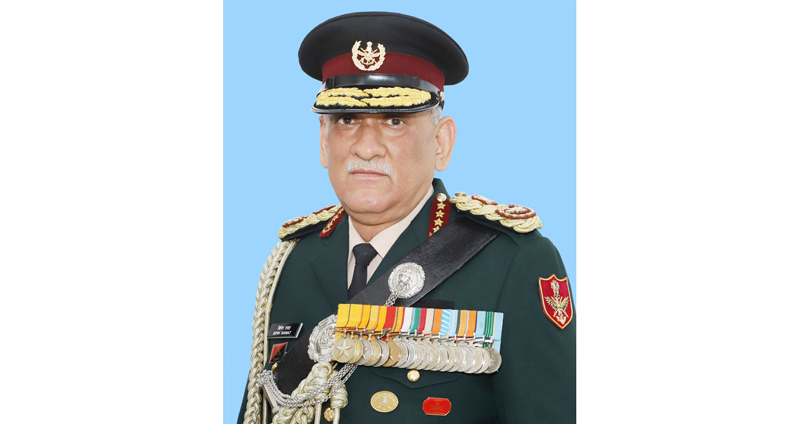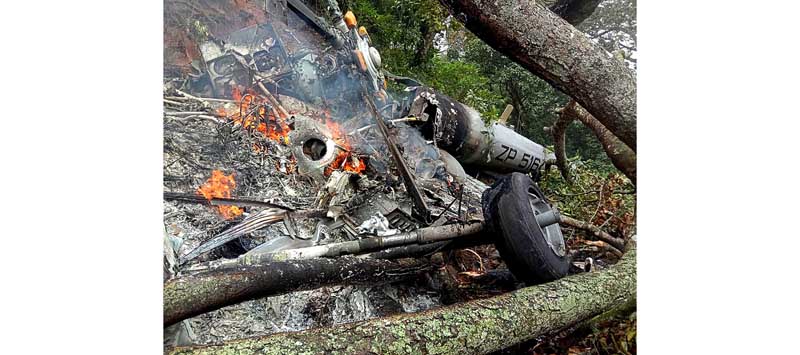Chopper was flying low in foggy conditions
COONOOR (TN)/NEW DELHI, Dec 8: Gen Bipin Rawat, India’s first Chief of Defence Staff who had a vast experience across a wide spectrum of conflict and terrain profiles, was among the 13 people killed today when the military helicopter they were travelling in crashed in a hilly area in apparently foggy conditions near Coonoor in Tamil Nadu, the Indian Air Force (IAF) and State officials said.
Click here to watch video
The Mi-17V5 helicopter carrying Gen. Rawat, the 63-year-old tri-services chief who would have completed two years at the end of this month in the new post after serving as the Army chief, crashed killing 13 of the 14 people on board including his wife and 11 other armed forces personnel, the officials said. The lone survivor, Group Captain Varun Singh, Directing Staff at DSSC, is currently under treatment at a military hospital in nearby Wellington, the IAF said.
Gen. Rawat, an outspoken General with his remarks sometimes kicking up a controversy, was on a visit to the Defence Services Staff College (DSSC), Wellington (Nilgiri Hills) to address the faculty and student officers of the Staff Course
The IAF said a Court of Inquiry has been ordered into the accident.
Mi-17V5 is an advanced military transport chopper that has been with the IAF since 2012. Manufactured by Russian Helicopters’ subsidiary Kazan, it has an onboard weather radar and is equipped with the latest generation of night vision devices.
“With deep regret, it has now been ascertained that Gen Bipin Rawat, Mrs Madhulika Rawat and 11 other persons on board have died in the unfortunate accident,” the IAF said in a tweet at around 6 pm. Earlier, the Nilgiris Collector SP Amrith confirmed that 13 persons were killed in the crash while there was one survivor.
The helicopter carrying Rawat and others had left Sulur IAF station in nearby Coimbatore around 11.48 am and was supposed to land at DSSC in Wellington at Udhagamandalam about 45 minutes later, official sources said, adding the mishap occurred at 12.22 pm. The CDS had earlier reached the IAF station from Delhi by an Embraer aircraft at 11.34 am.
The other victims, all from the armed forces, were identified as Brigadier LS Lidder, Lieutenant Colonel Harjinder Singh, Wing Commander PS Chauhan, Squadron Leader K Singh, Naik Gursewak Singh, Naik Jitender Kumar, Lance Naik Vivek, Lance Naik B S Teja, Havaldar Satpal, JWO Das and JWO Pradeep, according to official sources.
The accident site presented a gory picture as rescue personnel were seen picking up charred, severed limbs strewn around.
The mangled and burnt remains of the ill-fated IAF copter at the accident site in Nilgiris bore a grim testimony to the tragedy that shocked the nation. The site remained out of bounds for civilians.
The mortal remains of the victims will be taken to New Delhi from Coimbatore tomorrow by air, after a wreath-laying ceremony scheduled tomorrow morning at Wellington, police and Defence sources said.
Prime Minister Narendra Modi led Cabinet Committee on Security (CCS) was also briefed about the helicopter crash.
Besides Modi, the meeting was attended by Rajnath Singh, Home Minister Amit Shah, Finance Minister Nirmala Sitharaman and External Affairs Minister S Jaishankar, official sources said.
Singh, who earlier briefed the Prime Minister about the crash, also visited the residence of Rawat in the national capital and spoke to his younger daughter. Gen. Rawat is survived by two daughters. Singh said he was “deeply anguished” by the sudden demise of Gen. Rawat and others in the “extremely unfortunate helicopter” accident.
According to accounts of official sources and a local eyewitnesses in Coonoor, the helicopter was flying at a low altitude in the foggy conditions when it crashed into a valley near Coonoor, before falling through trees.
Fire engulfed the helicopter by the time it crashed on the ground. The helicopter crashed in the Katteri-Nanchappanchathram area in the hilly Nilgiris district.
Although the chopper brushed a house during its fall, there was no human casualty or injury since the residents were not at home. The building, however, suffered damage. Two persons, who were ablaze, fell down from the helicopter, Perumal, an eyewitness said.
The copter crashed in the forest area, reducing trees to pieces of logs and ashes due to resultant fire, even as the local people turned first responders to try and save the injured. However, they could not help the victims due to the raging flames and informed authorities.
Apparently, a major tragedy was averted as the crashing helicopter fell at some distance away from the human habitation, averting possible mass casualties.
Flames from the helicopter engulfed the wooden logs and smoke billowed while the locals and rescue personnel scurried to douse the fire by using buckets and a water hose.
Gen. Rawat, who hailed from Pauri in Uttarakhand, had last visited his native village in 2018 and had plans to build a house there after his retirement, his uncle recalled after news broke out about the death of the quintessential military commander.
His uncle Bharat Singh Rawat (70) had gone to Kotdwar for some work but returned home as soon as he heard about the accident. It is only the General’s family that lives at Saina village of Dwarikhal block.
The General’s uncle said teary-eyed people from nearby villages offered condolences to the family.
He said Bipin Rawat had offered prayers to their “kuldevata” during his last visit to the village in 2018.
The General left on the same day and had said he would build a house in the village after his retirement, Bharat Singh Rawat recalled.
As CDS, Gen. Rawat was overseeing the implementation of an ambitious tri-services modernisation plan to bring synergy among the armed forces and enhance their overall combat capabilities. He had also prepared plans for jointness of the Armed Forces.
Gen. Rawat had served as the Chief of the Indian Army from December 17, 2016, to December 31, 2019. He was appointed as India’s first Chief of Defence Staff on December 31, 2019.
Army chief Gen MM Naravane and all ranks of the force also expressed their condolences.
“The dynamic and inspiring leadership of General Bipin Rawat shall remain eternally etched in our memories. The #IndianArmedForces will forever remain indebted to his invaluable contributions,” the army tweeted. (PTI)
Credited with bringing down militancy in J&K
 A quintessential military commander, Gen Bipin Rawat possessed an uncanny understanding of geopolitical uphea-vals, calibrated a tri-services military doctrine to make India face myriad security challenges, and is largely credited with bringing down militancy in the Northeast and Jammu and Kashmir.
A quintessential military commander, Gen Bipin Rawat possessed an uncanny understanding of geopolitical uphea-vals, calibrated a tri-services military doctrine to make India face myriad security challenges, and is largely credited with bringing down militancy in the Northeast and Jammu and Kashmir.
As India’s first Chief of Defence Staff, Gen Rawat was tasked to bring in theatre command and jointness among the three services, and he was pushing it with a tough approach and specific timelines in the last two years.
Known to be forthright, fearless, and blunt at times, the outstanding military commander ruffled many feathers with his controversial remarks during his tenure as Army Chief and Chief of Defence Staff.
He strongly backed a policy of hot pursuit in dealing with cross-border terrorism and militancy in Jammu and Kashmir when he was the Army Chief between 2016 and 2019.
Much before the Doklam standoff in 2017, Gen Rawat had highlighted that India’s primary and long-term security challenge would come from an increasingly assertive China and that India needed to modernise its armed forces to confront it.
Gen Rawat had also played a major role in successfully carrying out the 2015 cross-border operation into Myanmar in response to a major ambush by Naga militants.
He was also part of the planning when India carried out surgical strikes against terror launch pads across the Line of Control in Pakistani-Occupied Kashmir that inflicted significant casualties on the adversary.
Gen Rawat was the Chief of Army Staff when Indian fighter jets pounded a Jaish-e-Mohammad terrorist training camp deep inside Pakistan’s Balakot, and was reportedly part of the decision-making process and provided key inputs for the operation.
The first sitting Chief of Army Staff to be appointed as the CDS, Gen Rawat had an illustrious career spanning over four decades during which he served with distinction in several conflict-ridden areas, including Jammu and Kashmir and the Northeast.
In 2017, Gen Rawat faced criticism for awarding the Chief of Army Staff’s Commendation card to Major Leetul Gogoi for efforts in counter-insurgency operations. Gogoi had tied a man to his military jeep purportedly as a shield against stone pelters during the 2017 Srinagar by-election.
In 2019, his comments relating to protests against the Citizenship Amendment Act triggered criticism.
In September, Gen Rawat talked about the theory of “clash of civilisations” while mentioning the western civilisation and China’s growing relations with countries like Iran and Turkey
A day later, External Affairs Minister S Jaishankar sought to distance the government from the controversial comments and said India had never subscribed to any clash of civilisations theory.
Rawat was born in Pauri, Uttarakhand, on March 16, 1958. His family had been serving in the Indian Army for multiple generations. His father Laxman Singh Rawat was from Sainj village of the Pauri Garhwal district and rose to the rank of Lt General.
Rawat attended Cambrian Hall School in Dehradun and the St. Edward’s School, Shimla.
He was a graduate of the Defence Services Staff College (DSSC), Wellington and the Higher Command Course at the United States Army Command and General Staff College at Fort Leavenworth, Kansas. Rawat was commissioned into the 5th battalion of 11 Gorkha Rifles on December 16, 1978,
As a Colonel, he commanded the 5th battalion of 11 Gorkha Rifles in the Eastern sector along the Line of Actual Control at Kibithu.
Promoted to the rank of Brigadier, he commanded 5 Sector of Rashtriya Rifles in Sopore. He then commanded a multinational Brigade in a Chapter VII mission in Congo under UN mission.
After promotion to Major General, Rawat took over as the General Officer Commanding 19th Infantry Division at Uri.
As a Lt General, he commanded III Corps headquartered in Dimapur before taking over the Southern Army in Pune.
He was appointed as the General Officer Commanding-in-Chief (GOC-in-C) Southern Command on 1 January 2016 and months later became the Vice Chief of Army Staff.
In December 2016, he was appointed as the 27th Chief of the Army Staff, superseding two senior Lt Generals, Praveen Bakshi and P M Hariz.
He is survived by two daughters. (PTI)


